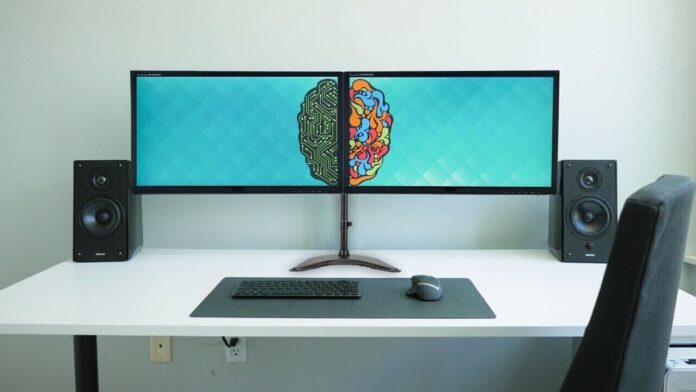A dual monitor setup is a game-changer. Whether you’re a gamer or a designer juggling multiple tasks, it can transform your workflow and boost productivity. But setting it up isn’t as simple as plugging in an extra screen.
Many people make avoidable mistakes that can reduce efficiency and even cause discomfort. To help you make the most of your dual monitor experience, here are five common mistakes to avoid and how to fix them.
1. Ignoring Desk Space And Monitor Placement
Your desk isn’t just a place to put your dual monitors, it’s the foundation of your setup. A common mistake is not considering the available space before purchasing dual monitors. This often leads to cramped setups that feel overwhelming and uncomfortable.
As per the report of Vision Council Approx 60% of American Adults experience eye strain symptoms due to screen light.
- How to Avoid It:
Measure your desk space first. Ensure your monitors will fit comfortably without taking over your entire workspace. Position the screens at eye level to avoid neck strain. Invest in monitor arms that can free up surface space if your desk is small. The goal is to create a clean, organized environment where your monitors feel like an enhancement, not a burden.
2. Choosing Mismatched Monitors
Grabbing any second monitor you find might be tempting, but using mismatched monitors can disrupt your workflow. Differences in resolution, screen size, or color accuracy can create visual inconsistencies, making it harder to multitask or work efficiently.
- How to Avoid It:
If possible, use identical monitors. This ensures consistency in size, resolution, and display quality. If that’s not feasible, try to find a second monitor with similar specifications to your primary one. Adjust the color settings of both monitors to match as closely as possible. This will give you a seamless viewing experience.
3. Skipping Cable Management
Nothing ruins the sleek look of a dual monitor setup faster than a jungle of tangled cables. Poor cable management doesn’t just look messy; it can also make troubleshooting difficult if you run into connectivity issues.
- How to Avoid It:
Plan your cable layout before connecting your monitors. Use cable clips, zip ties, or a cable management box to keep things tidy. Many monitor arms also come with built-in cable management features, which can be a lifesaver. A clean setup looks better and makes it easier to identify and fix issues if they arise.
4. Overlooking Ergonomics
One of the biggest advantages of a dual monitor setup is improving your workflow. However, overlooking ergonomics can negate these benefits. Poorly positioned monitors can lead to eye strain, neck pain, and long-term discomfort.
- How to Avoid It:
Follow the 20-20-20 rule: Every 20 minutes, look at something 20 feet away for 20 seconds to reduce eye strain. Ensure the monitors are at eye level, and the primary screen should be directly in front of you. If one monitor is used less frequently, position it slightly to the side. An adjustable chair, keyboard tray, and monitor stand can enhance your comfort and efficiency.
5. Forgetting To Optimize Display Settings
Failing to optimize your display settings can hold you back even after setting up your monitors physically. Common issues include incorrect resolutions, poor color calibration, and improperly aligned screens.
- How to Avoid It:
Access your computer’s display settings and adjust the resolution for each monitor to match its native resolution. Align the monitors so your cursor moves seamlessly between them. For color calibration, use built-in tools or external calibration devices to ensure accuracy, especially if you work in design or photography. Taking a few extra minutes to tweak these settings can make a huge difference in your user experience.
Bonus Tips For A Flawless Dual Monitor Setup
- Invest in Quality Peripherals
Don’t forget peripherals like a dual-monitor stand or a high-quality keyboard and mouse. These small upgrades can enhance your workflow and make your setup more enjoyable.
- Update Your Graphics Drivers
Ensure your graphics drivers are up to date. This not only improves performance but also prevents compatibility issues with your monitors.
- Test Your Setup
After setting up, test how the monitors work for your needs. Make adjustments as necessary to achieve a layout that feels natural and efficient.
Why A Well-Set Dual Monitor Setup Matters
A well-thought-out dual monitor setup isn’t just about aesthetics—it’s about creating a workspace that supports your goals. Avoiding these common mistakes will save time, reduce frustration, and maximize investment.
Whether gaming, designing, or just trying to stay on top of multiple tasks, a proper dual monitor setup can help you reach new levels of productivity and comfort. Take the time to set it upright, and you’ll wonder how you ever worked with just one screen.















